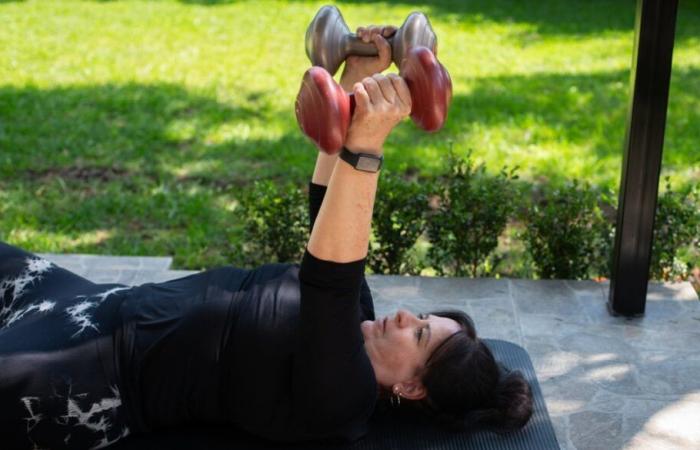According to an investigation published in the April 30 edition of the Alzheimer’s & Dementia magazine, Increase exercise at medium age could Help people prevent Alzheimer’s disease.
The scientists followed the brain Health of 337 people in Catalonia, Spain, who classified according to the physical activity guidelines that They recommended 150 to 300 minutes of moderate activity per week or 75 to 150 minutes of vigorous practices.
The study concluded that those between 45 and 65 years of age what They increased their exercises To comply with the recommended guidelines they had Less accumulation of beta amyloida toxic protein that forms plaques in the brains of patients with Alzheimer’s.
“Even those who did less physical activity of the recommended one had a higher cortical thickness than sedentary people, which suggests that Any amount of exercise, however minimal, has health benefits “said the principal researcher, Müge Akinci, researcher at the Global Health Institute in Barcelona, in Spain.
The researchers also pointed out that The more people increased their activity, the greater the reduction of amyloid beta in its brains.
The importance of exercise
Juan Cristobal Tapia Valladares, Master (C) In clinical physiology of the exercise, professor of the Faculty of Medical Sciences-Use and Curriculum Coordinator of the Physical Activity and Health Therapy career, he addressed the study cited and pointed to Diario Usach that it is effective that sport can help reduce this disease.
“Regular physical exercise is erected as a significant ally in decreasing the risk of developing Alzheimer’s disease and other forms of dementia. Recent research, reveal Powerful neuroprotective effects of physical activity. These include the promotion of neurogenesis (the creation of new neurons), the modulation of cerebral inflammation, the optimization of blood perfusion in the brain and the regulation of the levels of toxic proteins intrinsically linked to the Alzheimer’s, such as amyloid beta and the Tau protein, ”he said.
The expert added that “comparative investigations between physically active and sedentary individuals yield overwhelming results: Those who incorporate the exercise in their routine have less cerebral atrophy, a more efficient executive function and a lower accumulation of the characteristic amyloid plaques. This preventive effect is observed even in the middle age (40-65 years), which underlines the importance of adopting active habits throughout life. ”
On What are beta amiloid, The specialist indicated that it is a “Protein that arises from an atypical processing of the amyloid precursor protein (App). A pathological conditionsthese proteins experience an anomalous accumulation, forming the so -called extracellular plates in the brain tissue. These plates They constitute one of the distinctive neuropathological seals of Alzheimer’s disease. ”
It is for this reason that research to reduce the production or promotion of the elimination of beta amyloid has become a primary therapeutic objective of scientists.

Why is it so important to perform physical activity and what exercises can be done?
Tapia Valladares said that “Physical inactivity is identified as a modifiable risk factor significantly associated with a greater risk of developing Alzheimer’s and other dementias. Scientific evidence, since 2020, points out that the lack of physical activity contributes to a series of mechanisms that favor both the beginning and the progression of Alzheimer’s disease. ”
The Usach academic added that “A regular and balanced physical routine in adults from 40 to 65 years Not only is it sure, but it constitutes a Effective strategy to prevent or delay the appearance of Alzheimer’spromoting brain health through multiple mechanisms. ”
In addition, he indicated that the Regular physical exercise practice displays a wide range of Crucial benefits in disease prevention:
• Neurogenesis and synaptic plasticity: It stimulates the production of BDNF and other neurotrophic factors, strengthening connections between neurons.
• Improvement of cerebral blood flow: It ensures adequate oxygenation and facilitates the elimination of toxic metabolic products from the brain.
• Reduction of oxidative stress and neuroinflamation: Counteracts the harmful processes that contribute to neuronal deterioration.
• Decreased amyloid beta and Tau protein: It helps regulate the levels of these pathological proteins.
• Improvement of executive function and memory: Strengthens functional and executive cognitive abilities.

In addition, the expert indicated that for adults in the age range of 40 to 65, various types of exercises are recommended that can be integrated into a healthy routine:
• Aerobic exercise: It is the activity par excellence. Actions like walk fast, run, swim or ride a bicycle, that raise heart rate and improve circulation and from moderate intensity. With them substantial benefits are observed, that means a level 4-5 of tiredness in a scale of 1 to 10 of self-perception of effort. Important accumulate at least 150 min per week.
• Exercise of resistance or strength: Training with moderate weights or elastic bands to strengthen the muscles, at least 2 times a weekexercising the large muscle groups.
• Multicomponent exercise: Combinations of aerobic, force, balance and coordination exercisessuch as boxing, martial arts, dance, or functional training.
• Dual cognitive exercise: Activities that require Physical coordination and mental caresimultaneously, such as choreographed dance or racket sports.









